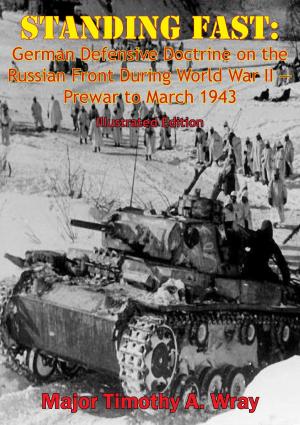Lithuanian Freedom Fighters' Tactics: Resisting The Soviet Occupation 1944-1953
Nonfiction, History, Germany, European General, Military, United States| Author: | Darius Bernotas | ISBN: | 9781782897088 |
| Publisher: | Verdun Press | Publication: | August 15, 2014 |
| Imprint: | Verdun Press | Language: | English |
| Author: | Darius Bernotas |
| ISBN: | 9781782897088 |
| Publisher: | Verdun Press |
| Publication: | August 15, 2014 |
| Imprint: | Verdun Press |
| Language: | English |
Although the end of World War II enabled devastated countries to rebuild and enjoy a time of peace, another bloody war had just started in Lithuania. Lithuanian Freedom Fighters (LFF) fought for almost a decade (1944-1953) against the Soviets who occupied their country after World War II. This research focuses on LFF tactics that enabled them to oppose greatly superior Soviet forces for an extended period of time and on the factors that resulted in eventual defeat of LFF armed resistance. The research utilized the elements of combat power as the measurement criteria to describe the LFF tactics.
The author concludes that the LFF tactics were to some extent effective. LFF managed to adapt tactics in accordance with a changing situation in terms of shifting Soviet tactics and wrong initial assumptions regarding international support. The other factor that contributed to the LFF success fighting the superior enemy for almost a decade was related to LFF ability to mitigate LFF combat power elements’ weaknesses while exploiting their strengths.
Nevertheless, the absence of both political and material international support along with Soviet success in cutting off population support to the LFF were two main reasons that resulted in the gradual defeat of the armed resistance.
As asymmetric warfare is likely to continue playing an important role in future conflicts, members of the military profession should find it useful to familiarize themselves with this research. A thorough analysis of LFF tactics employing a combination of regular and irregular warfare to counter superior forces should assist military professionals in further deepening their understanding of asymmetric warfare phenomena thus contributing to their awareness of contemporary operational environment.
Although the end of World War II enabled devastated countries to rebuild and enjoy a time of peace, another bloody war had just started in Lithuania. Lithuanian Freedom Fighters (LFF) fought for almost a decade (1944-1953) against the Soviets who occupied their country after World War II. This research focuses on LFF tactics that enabled them to oppose greatly superior Soviet forces for an extended period of time and on the factors that resulted in eventual defeat of LFF armed resistance. The research utilized the elements of combat power as the measurement criteria to describe the LFF tactics.
The author concludes that the LFF tactics were to some extent effective. LFF managed to adapt tactics in accordance with a changing situation in terms of shifting Soviet tactics and wrong initial assumptions regarding international support. The other factor that contributed to the LFF success fighting the superior enemy for almost a decade was related to LFF ability to mitigate LFF combat power elements’ weaknesses while exploiting their strengths.
Nevertheless, the absence of both political and material international support along with Soviet success in cutting off population support to the LFF were two main reasons that resulted in the gradual defeat of the armed resistance.
As asymmetric warfare is likely to continue playing an important role in future conflicts, members of the military profession should find it useful to familiarize themselves with this research. A thorough analysis of LFF tactics employing a combination of regular and irregular warfare to counter superior forces should assist military professionals in further deepening their understanding of asymmetric warfare phenomena thus contributing to their awareness of contemporary operational environment.






![Cover of the book 7 December 1941: The Air Force Story [Illustrated Edition] by Darius Bernotas](https://www.kuoky.com/images/2014/august/300x300/9781782895985-busd_300x.jpg)



![Cover of the book Why, How, Fleet Salvage And Final Appraisal [Illustrated Edition] by Darius Bernotas](https://www.kuoky.com/images/2014/august/300x300/9781782894452-7NSe_300x.jpg)

![Cover of the book From Gallipoli To Baghdad [Illustrated Edition] by Darius Bernotas](https://www.kuoky.com/images/2014/august/300x300/9781782895541-9iCj_300x.jpg)


![Cover of the book The Scots Guards in the Great War 1914-1918 [Illustrated Edition] by Darius Bernotas](https://www.kuoky.com/images/2015/november/300x300/9781786255532-qMuK_300x.jpg)